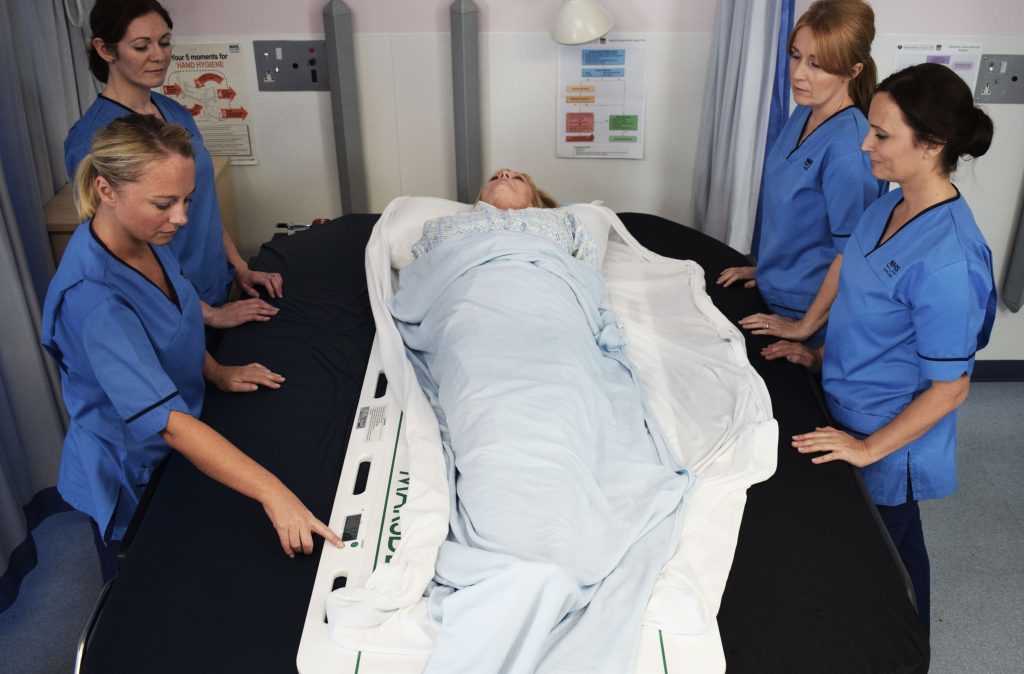Where is the Patient Transfer Scale used?

So where is the Patient Transfer Scale used so far, and how? This blog post investigates.
As a transfer board with inbuilt weighing scale, the Patient Transfer Scale is changing the way hospitals weigh immobile patients. From Emergency Departments and ICU to Stroke and Renal, more and more departments are asking about - and ordering - the Patient Transfer Scale.
The Patient Transfer Scale means patients can now be ‘weighed on admission, no matter what’, according to hospital staff.
What is the Patient Transfer Scale?
NICE guidelines (2006) state patients admitted to should have “a weight on admission and then a weekly weight.” Yet when patients are immobile, getting a weight reading can be extremely difficult.
NHS Nurse, Gillian Taylor, came up with the idea of the Patient Transfer Scale. Working in the Emergency Department of University Hospital Monklands near Glasgow, she was becoming increasingly frustrated by the difficulties of weighing immobile patients.
“The only way to weigh an immobile patient was to use a hoist scale or a bed scale, but both were time consuming, and could be cumbersome too. I decided there must be an easier way to weigh these patients,”
“I realised that if a patient is weighed as they are transferred to a bed, using a transfer board, they can be weighed quickly without time being taken to weigh them.” - Gillian Taylor
Why do you need an accurate weight reading?
Patient weight can be critical when delivering timely and accurate care and treatment. Getting a weight reading is patient is very important when medication or treatment needs to be administered quickly - however, it is not always easy to weigh the patient.
An accurate weight reading means an accurate drug dosage can be administered. Previously the only solutions for weighing immobile patients have been bed scales and hoist scales - these options can be cumbersome and time consuming.
According to Hilmer, one study showed that as many as 30% of patients were not weighed at all - despite being prescribed weight-based medication. Possibly due to lack of time and available (and suitable) weighing scales.
Darnis et al said, “An assessment of body weight is required for calculations of drug dosages.” However, issues such as immobility, trauma and burns means weights are estimated.
“Weight and height are rarely available when patients are admitted to the ICU. Since critically ill patients frequently arrive unconscious or otherwise incapacitated, accurate measurements of weight and height are often difficult to obtain.”
The Patient Transfer Scale is used is an already existing procedure - lateral transfer of a patient such as from a trolley to bed. This allows hospitals to weigh these patients accurately without taking up time.

You can read more about the risks of inaccurate weight reading in this white paper.
Where can the Patient Transfer Scale be used?
The PTS can be used anywhere in the hospital where an accurate weight reading is required for an immobile or time-critical patient.
Marsden spent over two years developing the Patient Transfer Scale, and in that time we visited dozens of hospitals for feedback. This gave us great insight into where using the Patient Transfer Scale would be most effective.
The Patient Transfer Scale is now being used throughout hospitals worldwide.
1. A&E
Emergency departments and A&E resus areas needed to administer medications quickly. Many drugs are now weight related and need to be administered quickly. For example if you have an infarct stroke, a drug called Alteplase can be used within a specific time frame to dissolve the clot.
Early treatments for stroke patients improves chance of recovery, reduces the likelihood of permanent disability and lessen the need for extensive rehabilitation. Thrombolysis for Ischaemic Stroke should take place as near to the onset of symptoms as possible for the best outcome. The medication dose is provided based on weight. Read more about the importance of weighing a patient who has suffered from a Stroke here.
Patients who overdose in Emergency Departments are prescribed antidotes related to weight.
Trauma patients who need a specific weight per kilogram can use the PTS. The patient may be situated on a trauma board, but the PTS features a Tare function which means the weight of this board can be deducted.
2. Medical Receiving
Receiving areas, such as medical receiving, surgical receiving, trauma and Orthopaedic receiving. All patients admitted to hospital require a weight within a four hour period. Although this target varies between each trust, it is standard practice to expect to have a weight on an admitted patient, then a weight every week (unless their condition states daily).
These departments administer specific weight related antibiotics, such as Vancomycin and Gentamicin. Giving an incorrect dosage could have harmful consequences - potentially not killing the bacteria, or damaging organs.
They can also require IV paracetamol, which is weight related within parameters, and enoxaparin which is given for blood clots is also weight related. Patients in Orthopaedic trauma have leg or hip fractures still require a weight as standard, but may also be on some of the aforementioned antibiotics.
3. Intensive care
Intensive care units tend to provide weight related drugs, or drugs based on ideal body weight. Patients in this setting are unable to stand on a weighing scale. Many ICU beds will have airflow mattresses. These work great with the PTS, so long as the mattress is static.
A weight reading also helps consultants make key decisions about dosages in patients in heart failure.
4. Cardiology
In cardiology departments, if the patient cannot use stand on scales, the PTS provides an accurate weight reading for heart failure.
Patients suffering from a heart attack go straight to CATH labs. Heparin is a weight related drug administered in Myocardial Infarctions.
For anaesthetic, if it’s an emergency and no weight is recorded from a pre-assessment with a weight then an accurate weight is extremely beneficial for the anaesthetic in theatres.
5. Care of the Elderly
In Care of the Elderly receiving, patient needs can be complex and they can be administered many of the medications above - requiring an accurate, easy to obtain weight reading in order to prescribe the right drug dosage.
Some patients will require Nutritional support (feeding via a NG tube). These patients could be anywhere in the hospital and require accurate weights for the dieticians to make a good assessment of their Nutritional status and monitor how the patient is responding.
For instructions on how to use the Patient Transfer Scale click here. Find out why you should choose the PTS over a bed or hoist scale here. For more information about the Patient Transfer Scale click here .